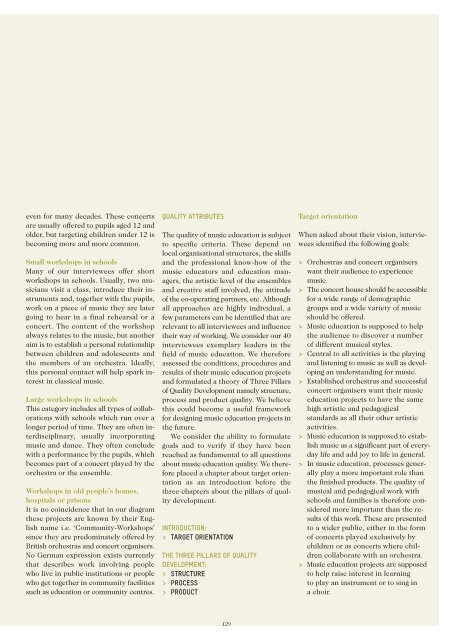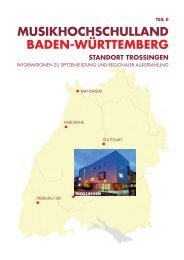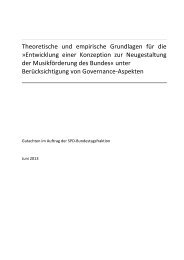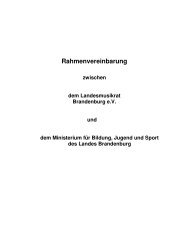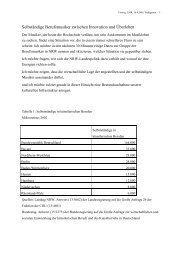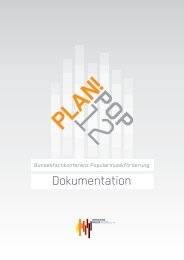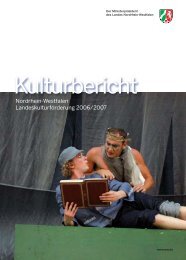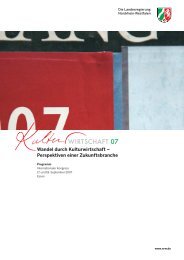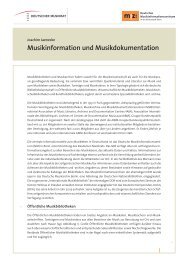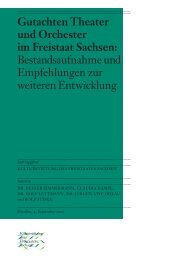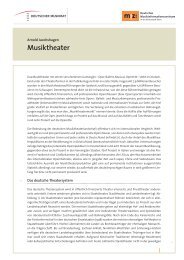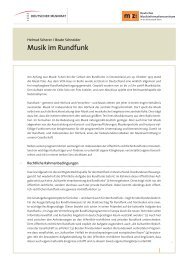EXCHANGE DIE KUNST, MUSIK ZU VERMITTELN - Miz.org
EXCHANGE DIE KUNST, MUSIK ZU VERMITTELN - Miz.org
EXCHANGE DIE KUNST, MUSIK ZU VERMITTELN - Miz.org
Sie wollen auch ein ePaper? Erhöhen Sie die Reichweite Ihrer Titel.
YUMPU macht aus Druck-PDFs automatisch weboptimierte ePaper, die Google liebt.
even for many decades. These concerts<br />
are usually offered to pupils aged 12 and<br />
older, but targeting children under 12 is<br />
becoming more and more common.<br />
Small workshops in schools<br />
Many of our interviewees offer short<br />
workshops in schools. Usually, two musicians<br />
visit a class, introduce their instruments<br />
and, together with the pupils,<br />
work on a piece of music they are later<br />
going to hear in a final rehearsal or a<br />
concert. The content of the workshop<br />
always relates to the music, but another<br />
aim is to establish a personal relationship<br />
between children and adolescents and<br />
the members of an orchestra. Ideally,<br />
this personal contact will help spark interest<br />
in classical music.<br />
Large workshops in schools<br />
This category includes all types of collaborations<br />
with schools which run over a<br />
longer period of time. They are often interdisciplinary,<br />
usually incorporating<br />
music and dance. They often conclude<br />
with a performance by the pupils, which<br />
becomes part of a concert played by the<br />
orchestra or the ensemble.<br />
Workshops in old people’s homes,<br />
hospitals or prisons<br />
It is no coincidence that in our diagram<br />
these projects are known by their English<br />
name i.e. ‘Community-Workshops’<br />
since they are predominately offered by<br />
British orchestras and concert <strong>org</strong>anisers.<br />
No German expression exists currently<br />
that describes work involving people<br />
who live in public institutions or people<br />
who get together in community facilities<br />
such as education or community centres.<br />
QUALITY ATTRIBUTES<br />
The quality of music education is subject<br />
to specific criteria. These depend on<br />
local <strong>org</strong>anisational structures, the skills<br />
and the professional know-how of the<br />
music educators and education managers,<br />
the artistic level of the ensembles<br />
and creative staff involved, the attitude<br />
of the co-operating partners, etc. Although<br />
all approaches are highly individual, a<br />
few parameters can be identified that are<br />
relevant to all interviewees and influence<br />
their way of working. We consider our 40<br />
interviewees exemplary leaders in the<br />
field of music education. We therefore<br />
assessed the conditions, procedures and<br />
results of their music education projects<br />
and formulated a theory of Three Pillars<br />
of Quality Development namely structure,<br />
process and product quality. We believe<br />
this could become a useful framework<br />
for designing music education projects in<br />
the future.<br />
We consider the ability to formulate<br />
goals and to verify if they have been<br />
reached as fundamental to all questions<br />
about music education quality. We therefore<br />
placed a chapter about target orientation<br />
as an introduction before the<br />
three chapters about the pillars of quality<br />
development.<br />
INTRODUCTION:<br />
> TARGET ORIENTATION<br />
THE THREE PILLARS OF QUALITY<br />
DEVELOPMENT:<br />
> STRUCTURE<br />
> PROCESS<br />
> PRODUCT<br />
129<br />
Target orientation<br />
When asked about their vision, interviewees<br />
identified the following goals:<br />
> Orchestras and concert <strong>org</strong>anisers<br />
want their audience to experience<br />
music.<br />
> The concert house should be accessible<br />
for a wide range of demographic<br />
groups and a wide variety of music<br />
should be offered.<br />
> Music education is supposed to help<br />
the audience to discover a number<br />
of different musical styles.<br />
> Central to all activities is the playing<br />
and listening to music as well as developing<br />
an understanding for music.<br />
> Established orchestras and successful<br />
concert <strong>org</strong>anisers want their music<br />
education projects to have the same<br />
high artistic and pedagogical<br />
standards as all their other artistic<br />
activities.<br />
> Music education is supposed to establish<br />
music as a significant part of everyday<br />
life and add joy to life in general.<br />
> In music education, processes generally<br />
play a more important role than<br />
the finished products. The quality of<br />
musical and pedagogical work with<br />
schools and families is therefore considered<br />
more important than the results<br />
of this work. These are presented<br />
to a wider public, either in the form<br />
of concerts played exclusively by<br />
children or as concerts where children<br />
collaborate with an orchestra.<br />
> Music education projects are supposed<br />
to help raise interest in learning<br />
to play an instrument or to sing in<br />
a choir.


